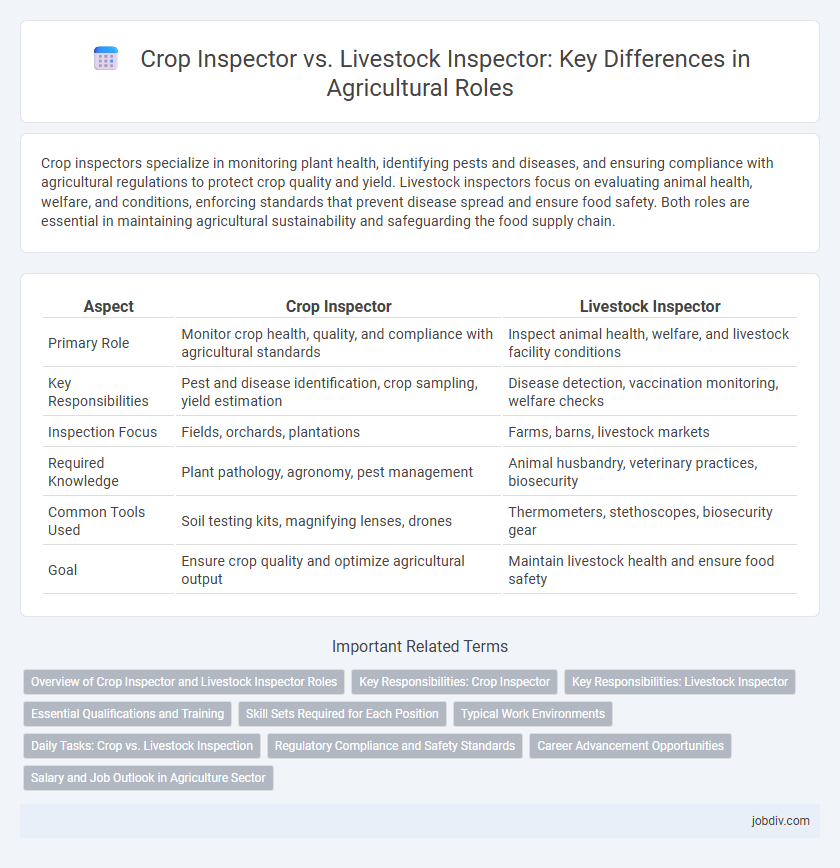Crop inspectors specialize in monitoring plant health, identifying pests and diseases, and ensuring compliance with agricultural regulations to protect crop quality and yield. Livestock inspectors focus on evaluating animal health, welfare, and conditions, enforcing standards that prevent disease spread and ensure food safety. Both roles are essential in maintaining agricultural sustainability and safeguarding the food supply chain.
Table of Comparison
| Aspect | Crop Inspector | Livestock Inspector |
|---|---|---|
| Primary Role | Monitor crop health, quality, and compliance with agricultural standards | Inspect animal health, welfare, and livestock facility conditions |
| Key Responsibilities | Pest and disease identification, crop sampling, yield estimation | Disease detection, vaccination monitoring, welfare checks |
| Inspection Focus | Fields, orchards, plantations | Farms, barns, livestock markets |
| Required Knowledge | Plant pathology, agronomy, pest management | Animal husbandry, veterinary practices, biosecurity |
| Common Tools Used | Soil testing kits, magnifying lenses, drones | Thermometers, stethoscopes, biosecurity gear |
| Goal | Ensure crop quality and optimize agricultural output | Maintain livestock health and ensure food safety |
Overview of Crop Inspector and Livestock Inspector Roles
Crop Inspectors primarily evaluate the health, quality, and compliance of crops with agricultural standards, focusing on pest control, disease identification, and ensuring proper use of fertilizers and pesticides. Livestock Inspectors concentrate on the welfare, health, and sanitation standards of farm animals, monitoring for diseases, proper animal handling, and adherence to regulatory guidelines. Both roles are essential in maintaining agricultural productivity and food safety, with Crop Inspectors specializing in plant-based assessments and Livestock Inspectors overseeing animal husbandry practices.
Key Responsibilities: Crop Inspector
Crop Inspectors are responsible for monitoring the health and quality of crops by examining plants for diseases, pests, and nutrient deficiencies. They collect soil and plant samples for laboratory analysis to ensure compliance with agricultural standards and regulations. Their role also includes advising farmers on best practices for pest control and crop management to optimize yield and sustainability.
Key Responsibilities: Livestock Inspector
Livestock Inspectors are responsible for ensuring the health and welfare of farm animals by monitoring living conditions, detecting signs of disease, and enforcing compliance with animal health regulations. They conduct regular site inspections, review medical records, and may collect samples for laboratory analysis to prevent the spread of infectious diseases. Their role is critical in maintaining biosecurity standards and supporting sustainable livestock production systems.
Essential Qualifications and Training
Crop inspectors require specialized training in plant pathology, soil science, and pest management, often holding degrees in agricultural science or horticulture. Livestock inspectors must possess knowledge in animal health, welfare regulations, and disease control, typically supported by veterinary or animal science qualifications. Both roles necessitate certifications in safety standards and practical field experience to ensure compliance with agricultural and biosecurity regulations.
Skill Sets Required for Each Position
Crop Inspectors require strong knowledge of plant diseases, soil conditions, and pest management techniques to accurately assess crop health and recommend treatments. Livestock Inspectors must possess expertise in animal anatomy, disease symptoms, and proper handling procedures to ensure the health and welfare of farm animals. Both positions demand keen observational skills, attention to detail, and familiarity with relevant safety regulations to maintain agricultural standards.
Typical Work Environments
Crop Inspectors typically work in outdoor agricultural fields, greenhouses, and processing facilities where they monitor plant health, pest control, and compliance with agricultural regulations. Livestock Inspectors operate in barns, farms, slaughterhouses, and livestock markets, ensuring animal health, welfare, and adherence to safety standards. Both roles require frequent fieldwork but differ in their focus on plants versus animals and the specific environments associated with each.
Daily Tasks: Crop vs. Livestock Inspection
Crop inspectors conduct daily tasks involving field surveys to assess plant health, identify pest infestations, and verify compliance with agricultural regulations. Livestock inspectors focus on examining animals for signs of disease, ensuring proper living conditions, and monitoring feed quality to maintain animal welfare standards. Both roles require detailed record-keeping and reporting to regulatory agencies to support food safety and farm productivity.
Regulatory Compliance and Safety Standards
Crop inspectors ensure regulatory compliance by verifying adherence to pesticide usage, plant quarantine measures, and quality standards that protect crop health and consumer safety. Livestock inspectors enforce safety standards related to animal health, disease control, feed quality, and humane treatment to prevent zoonotic diseases and ensure food safety in meat and dairy products. Both roles are critical in upholding agricultural regulations, but crop inspectors focus on plant-based production, while livestock inspectors specialize in animal-based sectors.
Career Advancement Opportunities
Crop Inspectors often advance to roles such as agricultural specialists or extension agents by gaining expertise in pest management and crop production technologies. Livestock Inspectors can progress to animal health specialists or regulatory compliance officers through experience in disease control and animal welfare standards. Both careers benefit from certifications and advanced degrees that enhance their expertise and open leadership positions within agricultural departments.
Salary and Job Outlook in Agriculture Sector
Crop inspectors typically earn an average salary ranging from $40,000 to $60,000 annually, with job growth projected at about 5% over the next decade due to increased demand for food safety and sustainable farming practices. Livestock inspectors generally have a salary range of $38,000 to $55,000 per year, with employment opportunities expected to grow around 4%, driven by the need to monitor animal health and compliance with agricultural regulations. Both roles are essential in the agriculture sector, offering stable career prospects with moderate salary levels and steady job outlooks linked to food security and regulatory enforcement.
Crop Inspector vs Livestock Inspector Infographic

 jobdiv.com
jobdiv.com